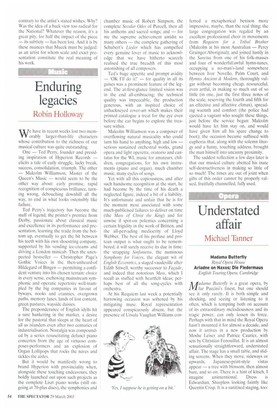Playing with scale
Andrew Lambirth
Ron Mueck: Making Sculpture at the National Gallery National Gallery until 22 June
Tn 1990, the National Gallery appointed 1Paula Rego as its first Associate Artist. The idea was to invite an established artist to come and work for a year or two in a basement studio at the gallery, making art that was a direct response to the NG's permanent collections. Since Rego's residency, there have been four other artists: Ken Kiff, Peter Blake. Ana Maria Pacheco and then Ron Mueck, who took up his tenure in August 1999, and now shows the fruit of his subsequent labours, in the Sunley Room, admission free.
Actually, the idea of having a contemporary artist on the spot to liven up all that past achievement is not all that new. In 1980, Maggi Hambling was the first of a whole string of younger Artists-inResidence to be appointed, and among the works she made was a powerful study after Rubens's 'Samson and Delilah', and a very popular portrait of one of the gallery's guards. Perhaps some of the following resident artists paid less attention to the treasures of the collection than was hoped, which necessitated re-launching the scheme in 1990 with a new name. Certainly since then the work produced by the Associate Artists has been stimulating to the extent of controversial, and has added different strata of appeal to (and often insight into) the nation's remarkable collection of Old Masters.
Ron Mueck was born in 1958 in Melbourne, Australia, of German emigre parents. The first sculpture by him that I remember seeing was a small Pinocchio in the 1996 Hayward Gallery theme show Spellbound: Art and Film, in which the three-dimensional figure was an effective adjunct to a group of paintings by Paula Rego relating to Disney's films. Rego is Mueck's mother-in-law, and she utilised his exceptional gifts as a special effects model-maker (working mostly in children's TV, motion pictures and advertising) to make a startlingly life-like Pinocchio which threw her own two-dimensional images into sharp relief. The next sighting of Mueck was in the Royal Academy's 1997 Sensation exhibition, in which he exhibited for the first time as an artist in his own right, represented by an almost unbearably poignant and considerably-less-than-lifesize sculpture entitled 'Dead Dad'.
Many people regard 'Dead Dad' as Mueck's high point — what could he do after that without repeating himself? He is a faultless craftsman, who works in a traditional manner: first making clay studies, then a full-size clay model from which he takes a mould, afterwards using it to cast his figures in fibreglass or silicone. He achieves marvels of verisimilitude — if not 'warts and all', then certainly moles and the delicate blue tracery of veins, and utterly convincing skin textures such as shaved hair follicles. But is it art? Do we get from Mueck's figures the transformation and originality that true art brings?
The NG's exhibition consists of four sculptures and a display case of related material — drawings, masks and models. Opposite these studies is a neatly parcelled baby on a pillow, wrapped in swaddling clothes and tied up with string. Ironically, this tiny figure is Mueck's first ever lifesize sculpture, everything else he does being bigger or smaller than the human scale. Like the other sculptures in the show, it is a reflection on the theme of mother and child, which is Mueck's somewhat broad response to the National's collections and the predominance of the Madonna with Christ Child. Another sculpture presents a (midget) mother with newborn babe crouching on her stomach and still attached by umbilical cord, while round a corner a vast pregnant figure towers over the fourth exhibit — a little naked man peering suspiciously from the prow of a boat. (What has this to do with motherhood, you may ask? Well, it's about the more general but related themes of containment, and the vessel as birth metaphor. Besides perhaps making an oblique reference to a favourite motif of Ken Kiffs, one of the previous Associate Artists.)
Interestingly enough, it was Mueck's intention that 'Pregnant Woman' be first encountered from the rear, and thus the visitor would only discover her bulging belly — the ostensible reason for the sculpture — by moving around the figure. In other words, Mueck wanted the viewer to be struck first by the scale of the piece, rather than its topic. After all, playing with scale has always been his strong point as an artist, his real subject. Yet 'Pregnant Woman' is positioned in the Sunley Room with swollen stomach blaring at the public, contrary to the artist's stated wishes. Why? Was the idea of a back view too radical for the National? Whatever the reason, it's a great pity, for half the impact of the piece — its subtlety — has been lost. And it is by these nuances that Mueck must be judged: as an artist for whom scale and exact presentation constitute the real meaning of his work.









































































 Previous page
Previous page